In the world of plastic production, Design for Manufacturing (DFM) for injection moulding stands as a cornerstone of efficiency and quality. This comprehensive guide delves into the intricacies of DFM, offering insights into its principles, processes, and best practices.

Introduction to Design for Manufacturability (DFM)
What is DFM?
Design for Manufacturability (DFM) is the process of designing products to achieve the best possible manufacturing outcomes. It involves considering various factors that influence manufacturing during the design phase.
DFM enables companies to identify and address potential issues early on. This helps minimize costly changes later in the production process.
Importance of DFM in Manufacturing
Implementing DFM principles offers several benefits:
Cost Savings: By addressing manufacturability concerns during design, companies can reduce overall production costs. DFM helps avoid expensive modifications down the line.
Improved Quality: Designing with manufacturing in mind leads to higher quality products. It minimizes defects and ensures consistent results.
Faster Time-to-Market: DFM streamlines the transition from design to production. This allows companies to bring products to market more quickly.
Enhanced Collaboration: DFM promotes collaboration between design and manufacturing teams. It fosters a shared understanding of goals and constraints.
DFM is applicable across various industries, such as:
By embracing DFM, companies in these sectors can optimize their manufacturing processes. They can deliver high-quality products at lower costs.
Phases of the DFM Process
The Design for Manufacturability (DFM) process in plastic injection molding involves several key phases. These steps ensure that products are optimized for manufacturing from the start.
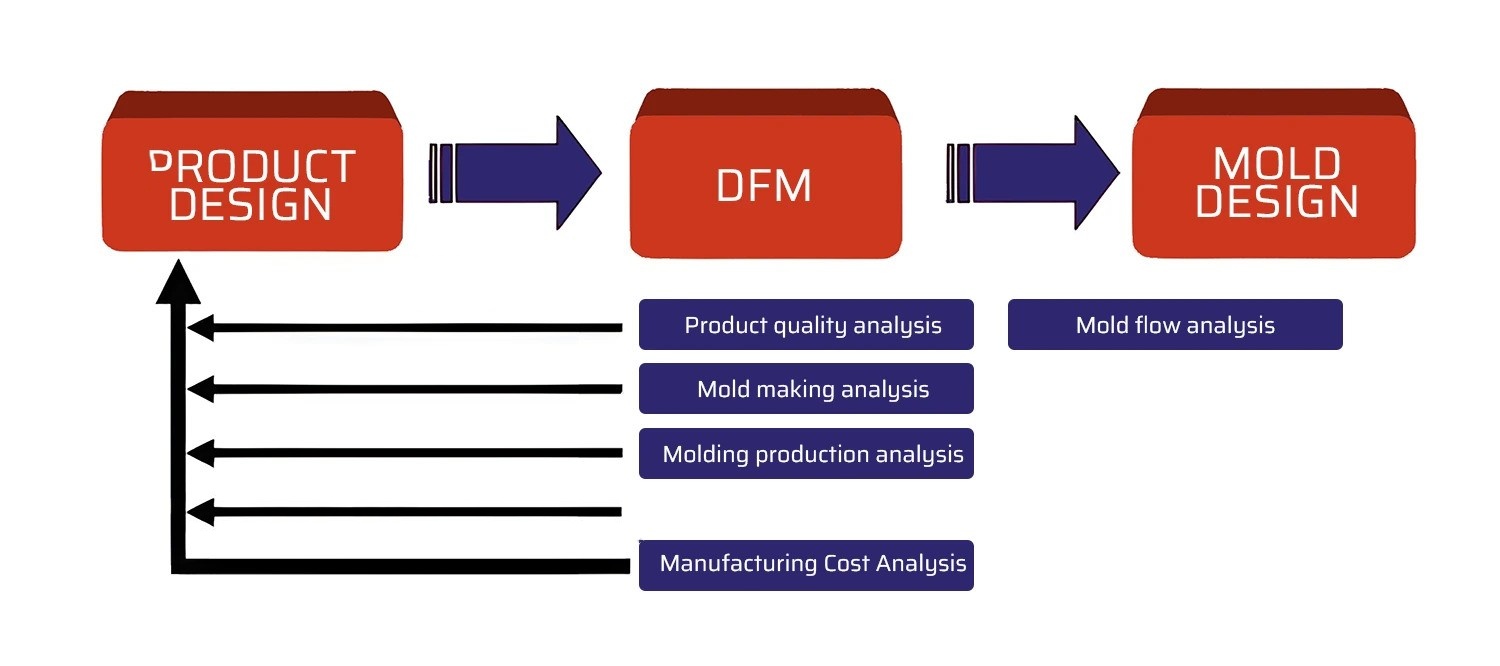
DFM analysis step
Phase 1: Analysis of Plans and Concerns
The first phase of DFM begins with the original equipment manufacturer (OEM) providing detailed project plans and documentation to the contract manufacturer (CM). This includes all relevant information about the product and its intended use.
The CM then reviews these materials to identify any potential manufacturability issues. They consider factors like part geometry, material selection, and tolerances.
Open communication between the OEM and CM is crucial at this stage. It helps address concerns early on.
Phase 2: DFM Simulation
In the second phase, engineers use advanced mold flow simulation software like Sigmasoft to analyze the injection molding process. These simulations provide valuable insights into how the material will behave during molding.
Key aspects evaluated in DFM simulations include:
By running these simulations, engineers can predict and prevent potential defects. They can optimize the design for the best possible manufacturing outcomes.
Phase 3: Presentation of Results and Recommendations
After completing the simulations, the CM compiles a detailed report of the results. This report includes specific recommendations to address any issues identified during the analysis.
The DFM report typically covers:
Material selection and mold conditions
Tested parameters such as injection temperature, pressure, and gate size
Comparative results for different design variants
Suggestions for prototyping and testing
The CM presents these findings to the OEM, along with their proposed solutions. They work together to refine the design for optimal manufacturability.
Phase 4: Prototyping, Testing, and Completion
In the final phase of DFM, the focus shifts to validating the optimized design through physical prototypes. 3D printing and additive manufacturing techniques are often used to create these prototypes quickly.
The prototypes undergo further testing and simulations to ensure they meet all requirements. Any necessary adjustments are made based on these results.
Once the design is finalized and approved, it moves into full-scale production. The DFM process helps ensure a smooth transition from design to manufacturing.
Key Considerations in DFM for Injection Moulding
When applying Design for Manufacturability (DFM) principles to plastic injection molding, several key factors must be considered. These include material selection, wall thickness, mold flow, draft angles, shrinkage, and undercuts.
Material Selection
Choosing the right material is crucial for successful injection molding. Several plastics are commonly used, each offering different properties that affect the design process.
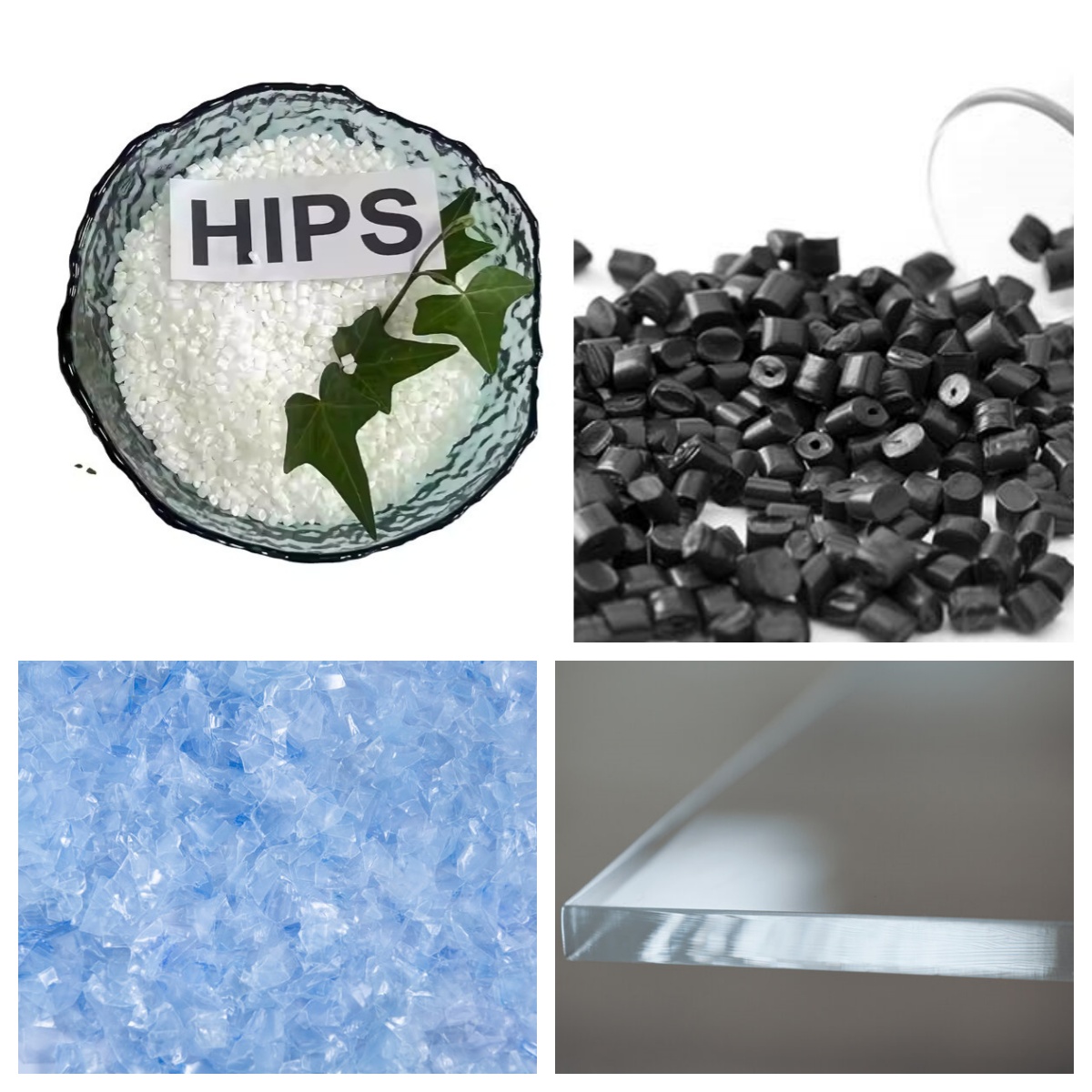
Some of the most frequently used materials include:
Each material has unique properties that influence how it behaves during molding. For example, Nylon shrinks more than PC, and ABS requires lower molding temperatures. Understanding these properties is essential for selecting materials that meet both design and production requirements. For a comprehensive guide on material selection, check out What Materials are Used in Injection Molding.
Wall Thickness Optimization
Optimizing wall thickness ensures parts cool evenly and avoid defects like sink marks or voids. Designers must follow recommended wall thickness guidelines for different plastics.
| Material |
Recommended Thickness |
| ABS |
1.5 to 4.5 mm |
| Polypropylene (PP) |
0.8 to 3.8 mm |
| Nylon |
2.0 to 3.0 mm |
| Polycarbonate (PC) |
2.5 to 4.0 mm |
Uniform wall thickness is critical for avoiding stress points. In cases where thin walls are needed, thin-wall molding techniques can be used. This method allows for weight reduction while maintaining part strength.
Designing for Proper Mold Flow
Ensuring good mold flow is another key aspect of DFM. Proper gate and runner system design impacts how the molten plastic fills the mold.
Gate Types: Choose between edge gates, fan gates, or direct gates based on part geometry and material flow. types of gates for injection molding
Runner Systems: Use balanced runner systems to ensure even distribution of material.
Mold Cooling: Effective cooling helps maintain dimensional stability and prevents warpage.
Cooling channels must be well-designed to ensure even temperature distribution throughout the mold.
Draft Angles and Surface Finish
Draft angles are essential for smooth part ejection from the mold. Without the proper angle, parts may stick to the mold, causing damage or defects. For more information, see our guide on draft angle in injection molding.
The recommended draft angles vary based on material and surface texture. For smooth surfaces, use a minimum of 0.5° to 1°. For textured surfaces, increase this to 3° to 5° to avoid scuffing or sticking.
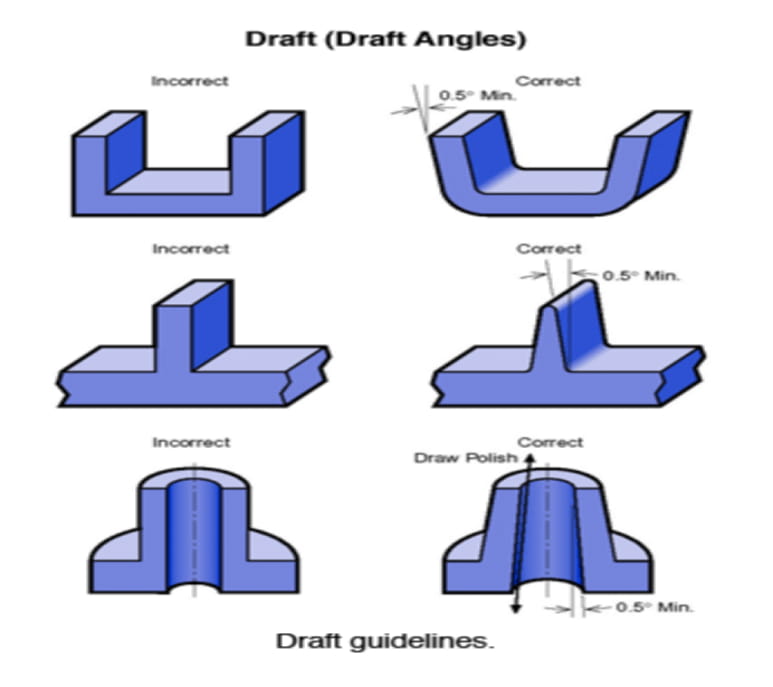
Shrinkage and Warpage Prevention
Shrinkage and warpage are common issues in injection molding. Designing for uniform shrinkage across the part reduces the likelihood of these problems. Thicker areas shrink more than thinner ones, so maintaining consistent wall thickness is key. Learn more about warping in injection molding
Proper ribbing and gusseting can also minimize warpage by reinforcing high-stress areas and distributing forces more evenly.
Undercuts and Side-Actions
Undercuts add complexity to the mold design and can complicate part ejection. Whenever possible, eliminate undercuts by adjusting part geometry. If undercuts are unavoidable, side-actions and split cores can be used to mold complex features. For more information on dealing with undercuts, check out our guide on ways to achieve injection molding undercuts.
Side-actions allow for easier part removal by shifting parts of the mold laterally before ejection, avoiding the need for complex tooling.
Tooling Considerations and Their Impact on DFM
Tooling plays a significant role in manufacturability. Processes like electrode machining and polishing influence part quality and precision. High-quality tooling leads to more consistent parts, better surface finishes, and reduced cycle times.
Polishing affects the final part’s finish. A highly polished mold can produce glossy surfaces, while textured molds provide matte finishes. Considering these factors during the design phase ensures the right tooling processes are used.
For more information on injection molding processes and considerations, visit our comprehensive guide on What is Injection Molding Process.
Checklist for DFM in Plastic Injection Molding
| DFM Checklist Item |
Description |
| Maximum pressure: filling |
Evaluate the pressure required to fill the mold. |
| Maximum pressure: packing |
Assess the pressure used during the packing stage to ensure material consistency. |
| Fill pattern animation |
Visualize how the molten plastic flows within the mold. |
| Inlet pressure curve |
Monitor pressure at the material inlet to ensure proper flow. |
| Clamp force estimation |
Estimate the force required to keep the mold closed during injection. |
| Temperature changes during filling |
Check for temperature variations during filling to avoid defects. |
| Frozen skin results |
Analyze the outer layer of the plastic that solidifies during cooling. |
| Shearing rate of the resin |
Measure the resin's shearing rate to evaluate flow properties. |
| Flow tracer animation |
Track the flow front of the molten plastic to identify issues. |
| Air traps |
Detect areas where air might get trapped and cause voids or incomplete parts. |
| Venting temperature |
Ensure adequate venting to maintain consistent temperature throughout the mold. |
| Weld lines |
Identify areas where two flow fronts meet, potentially causing weak spots. |
| Weld line tracer animation |
Visualize weld line formation to predict where material may weaken. |
| pvT chart analysis of weld lines |
Use the pvT chart to assess the material's behavior at specific cooling stages. |
| Material solidification during part cooling |
Monitor solidification to prevent uneven cooling and part defects. |
| Sink marks |
Evaluate surface depressions caused by improper cooling or excessive thickness. |
| Hot spots |
Identify areas of the part that are prone to overheating during injection. |
| Voids |
Detect internal air pockets that could affect part strength. |
| Thick areas of the part |
Check for excessive thickness that might cause sink marks or voids. |
| Thin areas of the part |
Ensure that thin sections are adequately filled to prevent incomplete parts. |
| Uniform wall thickness |
Design for even wall thickness to reduce defects like sink marks and warpage. |
| Material flow characteristics |
Ensure the selected resin flows well and can handle long or thin flow lengths. |
| Gate location |
Optimize gate location to prevent premature gate freezing and sink marks. |
| Multiple gate requirements |
Use multiple gates if necessary to ensure proper filling in complex geometries. |
| Gate impingement on steel |
Ensure that plastic flows properly onto steel surfaces to avoid splay. |
| Part draft angle |
Ensure adequate draft angles to allow for easy part ejection. |
| Texture release without scuffing |
Ensure draft is sufficient to release textured parts without damage. |
| Thin steel conditions in the tool |
Evaluate part geometry for sections that may create thin steel conditions. |
| Undercut simplification |
Consider design changes to eliminate or simplify undercuts. |
| Crystallization |
Check for any crystallization issues in the material that may affect part quality. |
| Fiber orientation |
Assess how fiber orientation could impact part strength and performance. |
| Shrinkage |
Evaluate the shrinkage behavior of the material to reduce dimensional variation. |
| Warpage |
Assess the potential for warping and how to mitigate it with design adjustments. |
Common Defects in Plastic Injection Molding Solved by DFM
Plastic injection molding is a complex process. It involves many variables that can lead to various defects in the final product. However, most of these issues can be prevented through proper Design for Manufacturability (DFM) practices. For a comprehensive overview of common defects, you can refer to our guide on injection molding defects.
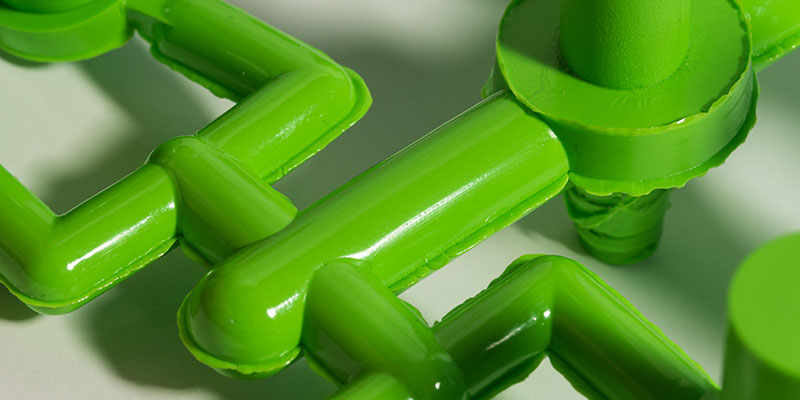
Key Defects
Flash: Flash occurs when excess plastic leaks out of the mold cavity, often where the two halves meet. It creates a thin layer of extra material that must be trimmed. Flashing is caused by insufficient clamp force or poor mold alignment. Learn more about injection molding flash.
Weld lines: Weld lines appear where two separate flows of molten plastic meet and fail to fuse properly. This creates weak spots, which can reduce part strength or alter its appearance. For more information, see our guide on injection molding weld line.
Sink marks: Sink marks are small depressions or dimples on the surface of a part. They occur when thicker sections of the part cool slower than thinner areas, causing the surface to collapse inward. Learn how to prevent sink mark in injection molding.
Short shots: A short shot happens when the mold cavity doesn’t completely fill with molten plastic, resulting in an incomplete part. This is often due to low injection pressure, inadequate material flow, or insufficient mold temperature. Discover more about short shot in injection molding.
Burn marks: Burn marks are dark or discolored areas caused by the material overheating or air trapping during injection. They can affect both the part’s appearance and structural integrity.
Brittleness: Brittleness refers to parts that crack or break easily due to insufficient strength. This defect can stem from improper material selection, poor cooling, or weak part design.
Delamination: Delamination is when the surface of a part shows visible layers that can peel away. This occurs when incompatible materials are used or moisture gets trapped in the resin during injection.
Jetting: Jetting happens when the plastic flows too quickly into the mold cavity, creating a snake-like pattern that distorts the part’s appearance and reduces its strength. Learn more about jetting in injection molding.
Voids, splay, bubbles, and blistering: Voids are air pockets that form inside the part. Splay refers to streaks caused by moisture in the material. Bubbles and blisters occur when trapped air fails to escape the mold, compromising the part’s strength and appearance. For more information on voids, see our article on vacuum voids.
Warping and flow lines: Warping results from uneven cooling, causing the part to bend or twist. Flow lines are visible streaks or waves on the surface of the part, usually caused by irregular flow patterns during injection. Learn more about warping in injection moldingand flow lines defect in injection molding.
Solutions Through DFM
To solve these defects, DFM (Design for Manufacturability) offers targeted adjustments to part and mold designs. Here are some common solutions:
Part Design Adjustments: Modify wall thickness to ensure uniform cooling. Add ribs or gussets to reinforce high-stress areas and prevent warping.
Mold Design Optimization: Ensure proper gate placement and size to eliminate weld lines and voids. Design cooling channels to maintain uniform temperature. Learn more about mold design.
Injection Pressure Control: Regulate injection pressure to avoid short shots and flash. Ensuring the right pressure helps to fully fill the mold cavity without overpacking.
Cooling Time Adjustments: Fine-tune cooling times to prevent warping, sink marks, and inconsistent solidification. Faster cooling times in thicker areas reduce the likelihood of shrinkage.
Material Selection: Choose materials with appropriate shrinkage rates and thermal properties for the part design. Material choice impacts everything from weld lines to overall strength. What Materials are Used in Injection Molding
By making these adjustments through DFM, manufacturers can drastically reduce or even eliminate these common injection molding defects.
Design Guidelines for Common Features in Injection Molding
When designing parts for plastic injection molding, it's crucial to consider the manufacturability of various features. Here are some guidelines for designing common elements in a way that optimizes production and minimizes defects. For a comprehensive overview, refer to our guide on What are Design Guidelines for Injection Molding.
1. Bosses
Bosses are raised features that serve as attachment points or structural supports. They are often used for screws, pins, or other fasteners.
Key guidelines for designing bosses:
Add a radius at the base, sized between 25-50% of the wall thickness.
Limit the height to no more than 3 times the outside diameter.
Use a draft angle of 0.5° to 1° on the outside for easier ejection.
Attach the boss to an adjacent wall using a connecting rib for added strength.
Locate multiple bosses no closer than twice the wall thickness.
2. Ribs
Ribs are thin, vertical walls that increase the stiffness of a part without adding significant mass. They are commonly used to reinforce flat surfaces or long spans.
Design tips for ribs:
Keep the thickness less than 60% of the main wall to avoid sink marks.
Limit the height to 3 times the thickness for stability.
Add a radius at the base, 25-50% of the thickness, to reduce stress concentration.
Use a draft angle of at least 0.5° per side for easy part removal.
3. Corners
Sharp corners are stress concentrators that can lead to part failure. They also make it difficult for plastic to flow smoothly during injection.
To avoid these issues:
Add a radius to all corners, inside and out.
Make the inside radius at least 50% of the wall thickness.
Match the outside radius to the inside radius plus the wall thickness.
4. Draft Angles
Draft angles are slight tapers added to vertical walls, pins, and ribs. They help the part release cleanly from the mold without sticking or deformation. For more information, see our guide on draft angle in injection molding.
The amount of draft needed depends on several factors:
Resin type: Materials with higher shrinkage rates require more draft.
Texture: Rougher surfaces need increased draft to prevent drag marks.
Depth: Taller features generally require more draft for clean ejection.
As a rule of thumb, use a minimum draft angle of 1° for smooth surfaces and 2-3° for textured ones. Consult with your molding partner for specific recommendations based on your design.

5. Ejector Pins
Ejector pins are used to push the finished part out of the mold cavity. Their size, shape, and location can affect the appearance and integrity of the part. Learn more about ejector pins in injection molding.
Keep these points in mind:
Place pins on non-cosmetic surfaces whenever possible.
Avoid putting pins on thin or fragile features that could be damaged during ejection.
Use a large enough pin to distribute the ejection force without leaving a visible mark.
Consider alternative ejection methods, such as stripper plates, for parts with complex geometry.
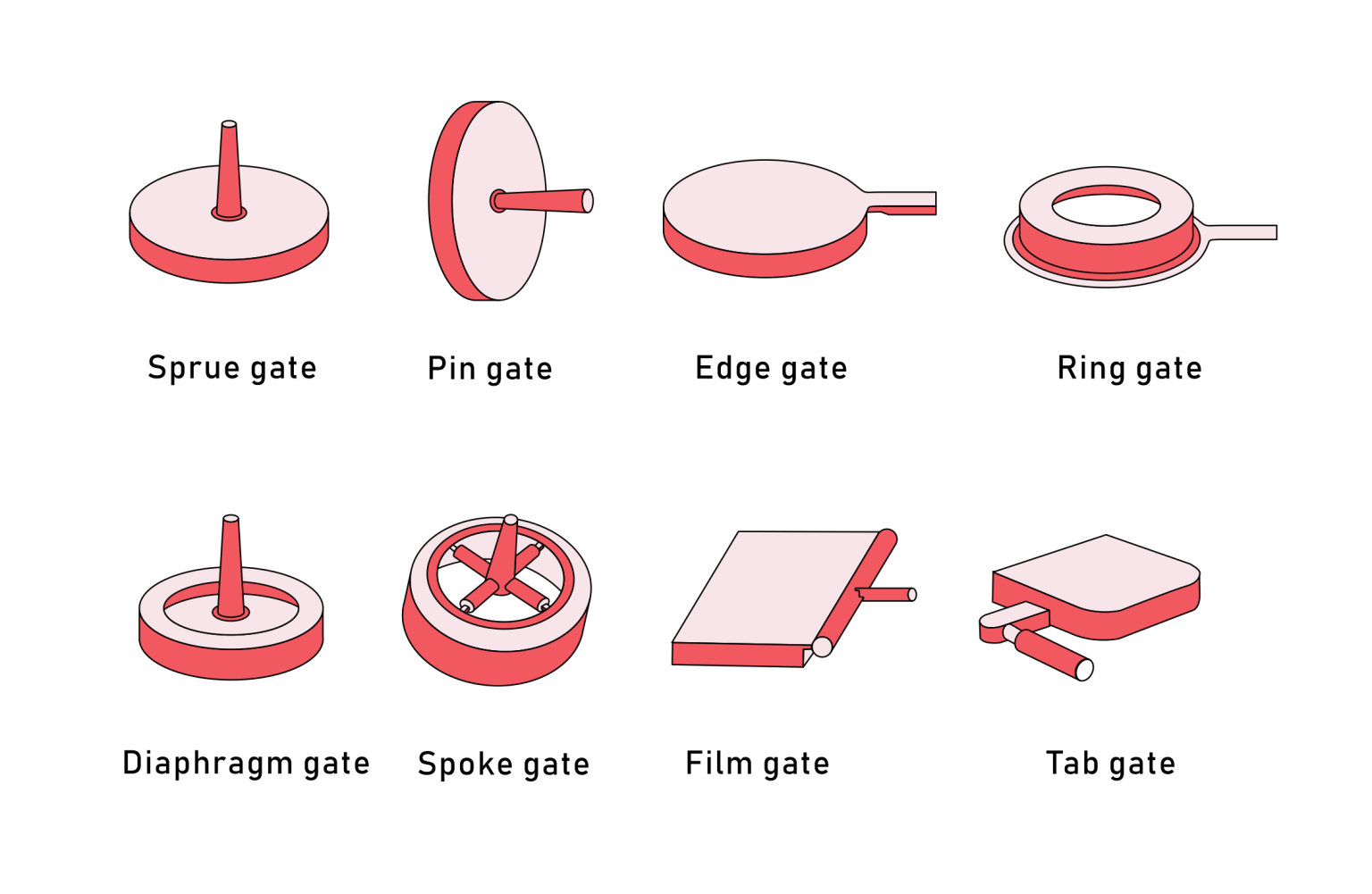
6. Gates
Gates are the openings through which molten plastic enters the mold cavity. Proper gate design is essential for achieving complete, balanced filling and minimizing visual defects. For more information, see our guide on types of gates for injection molding.
Some key considerations:
Select a gate type (e.g., tab, tunnel, hot tip) that suits the part geometry and resin.
Size the gate to allow for adequate flow without causing jetting or excessive shear.
Locate gates to promote even filling and packing of the cavity.
Place gates away from appearance surfaces or thick sections prone to sinks and voids.
7. Holes
Holes in injection molded parts are created using core pins in the mold. If not designed correctly, holes can be deformed or improperly sized.
Follow these guidelines:
Use a uniform wall thickness around the hole to prevent distortion.
Limit the depth of blind holes to no more than 2-3 times the diameter.
For through holes, support the core pin at both ends to maintain alignment.
Add a slight taper or draft to the hole for easier pin removal.
8. Parting Lines
Parting lines are the seams where the two halves of the mold come together. They are often visible on the finished part and can affect both aesthetics and function. Learn more about parting line in injection molding.
To minimize the impact of parting lines:
Position them on non-critical surfaces or edges of the part.
Use a "stepped" parting line for improved alignment and strength.
Add texture or a curved profile to disguise the appearance of the line.
Ensure adequate draft and clearance to prevent flash or mismatch at the parting line.
9. Texture
Textured surfaces can enhance the appearance, feel, and function of a molded part. However, they also require special considerations in design and tooling.
Keep these points in mind:
Use a draft angle of at least 1-2° to prevent the texture from inhibiting part ejection.
Avoid abrupt transitions or sharp edges in the texture pattern.
Consider the depth and spacing of the texture to ensure adequate resin flow and fill.
Work with your mold maker to select a texture that can be accurately machined or etched into the tool.
10. Shrinkage
All plastics shrink as they cool in the mold, and this shrinkage must be accounted for in the part and tool design. Uneven or excessive shrinkage can cause warping, sink marks, and dimensional inaccuracies.
To manage shrinkage:
Maintain a consistent wall thickness throughout the part.
Avoid thick sections that are prone to sinks and internal voids.
Use a mold temperature that promotes gradual, uniform cooling.
Adjust the packing pressure and time to compensate for material shrinkage.
Modify the tool dimensions based on the expected shrinkage rate of the resin.
11. Weld Lines
Weld lines occur when two or more flow fronts meet and fuse during the molding process. They can appear as visible marks on the surface and may represent weak points in the structure. For more information, see our guide on injection molding weld line.
To minimize the impact of weld lines, designers can:
Optimize gate locations to control the flow and meeting of the melt fronts.
Use a mold temperature that keeps the flow fronts hot and fluid as they converge.
Add vents or overflow wells to remove trapped air and improve fusion at the weld line.
Radius the corners and edges to promote better flow and a stronger weld.
Consider the use of a higher melt temperature or a slower fill rate in some cases.
While weld lines can't always be eliminated, these strategies help to manage their appearance and effect on part performance.
Here are a few additional tips and considerations for designing common features in injection molded parts:
For bosses:
Reinforce tall or slender bosses with gussets or ribs to prevent deflection or breakage during use.
For bosses that will be heat staked or ultrasonically welded, follow the guidelines provided by the equipment manufacturer for the best results.
For ribs:
Space ribs at least two times the nominal wall thickness apart to ensure adequate filling and minimize sink marks on the opposite surface.
For long or tall ribs, consider adding flow channels or thickness variations to promote even filling and reduce warp.
For corners:
Use a larger radius on outside corners compared to inside corners to compensate for the natural thinning of the material in those areas.
For structural or load-bearing parts, avoid sharp corners altogether and opt for a more gradual or chamfered transition.
For draft angles:
In addition to the primary draft on the walls, add a small amount of draft (0.25-0.5°) to features like ribs, bosses, and text to aid in ejection.
For parts with a high aspect ratio or deep draws, consider using a higher draft angle or incorporating a slide or cam action into the tool.
For ejector pins:
Use multiple pins in a balanced layout to distribute the ejection force and prevent distortion or damage to the part.
For round or cylindrical parts, consider using a sleeve ejector or a stripper plate instead of pins for a smoother and more uniform ejection.
For gates:
Avoid placing gates on corners or edges of the part, as this can lead to stress concentrations and gate vestige issues.
For large or flat parts, consider using a fan gate or a combination of multiple gates to achieve balanced filling and minimize warp.
For holes:
For small holes or those with tight tolerances, consider using a separate drill or ream operation after molding to ensure accuracy and consistency.
For internally threaded holes, use a threaded insert or a self-tapping screw to create the threads after molding.
For parting lines:
Avoid placing parting lines across critical dimensions or mating surfaces whenever possible.
For parts with a high cosmetic requirement, consider using a tool with a "shut-off" or "seamless" parting line design.
For texture:
Use a consistent texture depth and pattern across the part to ensure uniform cooling and shrinkage.
For parts with multiple textures or a combination of smooth and textured surfaces, use a gradual transition or a physical break to separate the different areas.
For shrinkage:
Use a material with a lower shrinkage rate or a higher filler content to minimize dimensional changes and warpage.
Consider using a multi-cavity tool with a balanced runner system to promote even shrinkage and consistency between parts.
For weld lines:
Use a material with a higher melt flow index or a lower viscosity to improve the fusion and strength of the weld line.
Consider using a gas-assist or overflow well technique to eliminate or relocate the weld line to a non-critical area of the part.
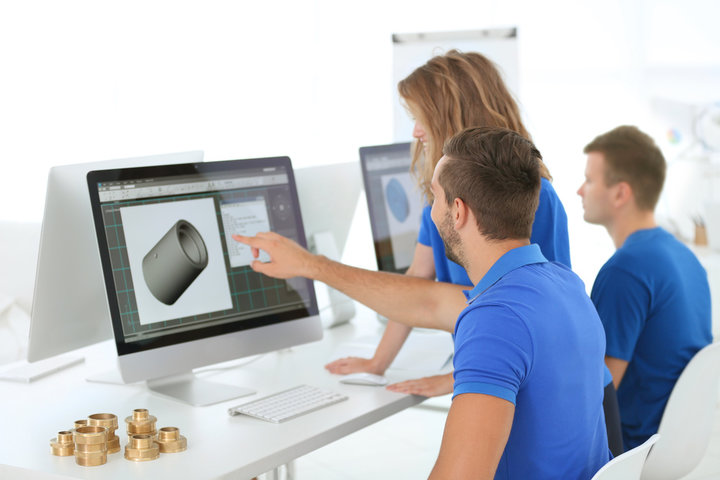
Case Study: Solving Quality Issues in Medical Device Manufacturing
Problem: Jetting and Poor Clarity in Medical Device Windows
A medical device manufacturer faced significant quality issues during production. The device, designed to help heal bones using ultrasound, had a transparent window that consistently failed inspection. The windows showed jetting and poor clarity, making the device unsuitable for medical use.
The root cause of this issue was substrate material re-melting and mixing with the clear resin. As the resin filled the mold, the temperature imbalance caused some material to re-melt and affect the clarity of the window. The mixing of incompatible materials during injection created distortions, leading to failed inspections.
Solution Through DFM
The contract manufacturer used Design for Manufacturability (DFM) principles to address these quality issues. Here’s how DFM helped fix the problem:
Revised Product Design and Tooling: The design was adjusted to prevent material re-melting. Modifications to the tooling ensured better separation between the clear resin and the substrate material. This step improved material flow, reducing the chance of jetting and other visual defects.
Use of 3D Printing for Prototyping and Testing: Before full-scale production, the manufacturer created prototypes using 3D printing. This allowed them to test and validate the design changes without committing to costly tooling adjustments. By prototyping first, they could see how the changes affected the part’s clarity and strength.
Introduction of Ultrasonic Welding and Value-Added Steps: In addition to design improvements, the manufacturing process incorporated ultrasonic welding. This process was used to join different parts of the device, ensuring better product integrity. Other value-added steps like product printing and additional quality checks were introduced to ensure consistency across all units.
Visualizing the Solution
| Issue |
Cause |
DFM Solution |
| Jetting in window |
Substrate material re-melting, mixing with resin |
Improved tooling, separation of materials |
| Poor clarity |
Mixing of materials, temperature imbalance |
Optimized design and better material flow |
| Failed product inspections |
Visual defects, weak bonds |
Added ultrasonic welding, 3D prototyping |
Conclusion
Design for Manufacturability (DFM) is essential in plastic injection molding. It helps avoid costly defects and improves product quality by addressing issues early. Key strategies include optimizing wall thickness, using proper gate locations, and ensuring smooth material flow. By applying these DFM principles, manufacturers can enhance efficiency, reduce production costs, and ensure consistent part quality.
Discover how Team Mfg can optimize your injection molding projects. Contact us today for a free consultation and quote. Let's collaborate to bring your designs to life, efficiently and cost-effectively.
FAQs About DFM for Injection Moulding
Q: What is the difference between DFM and DFA in injection moulding?
A: DFM focuses on optimizing part design for the injection molding process, while DFA emphasizes designing parts for easy assembly. DFM aims to reduce manufacturing complexity and cost, while DFA streamlines the assembly process.
Q: How does DFM affect the overall cost of an injection moulded product?
A: DFM helps reduce overall product cost by minimizing manufacturing complexity, reducing material usage, and optimizing the injection molding process. This leads to lower production costs, fewer defects, and shorter cycle times.
Q: Can DFM principles be applied to existing products?
A: Yes, DFM principles can be applied to existing products through a process called "design optimization." This involves analyzing the current design, identifying areas for improvement, and making modifications to enhance manufacturability.
Q: How often should a DFM analysis be performed during product development?
A: DFM analysis should be performed throughout the product development process, from initial concept to final design. Conducting regular DFM reviews helps identify and address potential issues early, reducing the need for costly changes later.
Q: What are the most common DFM-related issues in injection moulding?
A: Common DFM issues include inconsistent wall thickness, lack of draft angles, improper gate locations, and inadequate cooling. Other issues may involve poor material selection, uneven shrinkage, and excessive undercuts or complex geometries.

















